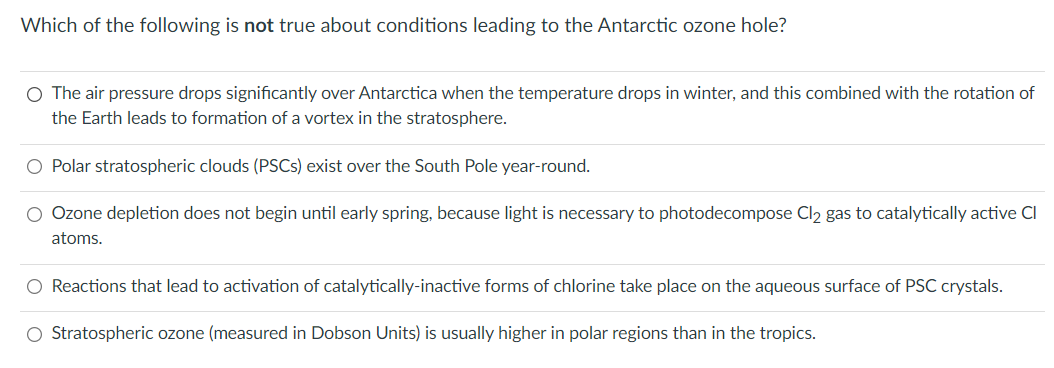Which of the following is not true about conditions leading to the Antarctic ozone hole? O The air pressure drops significantly over Antarctica when the temperature drops in winter, and this combined with the rotation of the Earth leads to formation of a vortex in the stratosphere. O Polar stratospheric clouds (PSCS) exist over the South Pole year-round. O Ozone depletion does not begin until early spring, because light is necessary to photodecompose Cl2 gas to catalytically active Cl atoms. O Reactions that lead to activation of catalytically-inactive forms of chlorine take place on the aqueous surface of PSC crystals. O Stratospheric ozone (measured in Dobson Units) is usually higher in polar regions than in the tropics.
Which of the following is not true about conditions leading to the Antarctic ozone hole? O The air pressure drops significantly over Antarctica when the temperature drops in winter, and this combined with the rotation of the Earth leads to formation of a vortex in the stratosphere. O Polar stratospheric clouds (PSCS) exist over the South Pole year-round. O Ozone depletion does not begin until early spring, because light is necessary to photodecompose Cl2 gas to catalytically active Cl atoms. O Reactions that lead to activation of catalytically-inactive forms of chlorine take place on the aqueous surface of PSC crystals. O Stratospheric ozone (measured in Dobson Units) is usually higher in polar regions than in the tropics.
Introductory Chemistry: A Foundation
9th Edition
ISBN:9781337399425
Author:Steven S. Zumdahl, Donald J. DeCoste
Publisher:Steven S. Zumdahl, Donald J. DeCoste
Chapter20: Organic Chemistry
Section: Chapter Questions
Problem 110AP
Related questions
Question

Transcribed Image Text:Which of the following is not true about conditions leading to the Antarctic ozone hole?
O The air pressure drops significantly over Antarctica when the temperature drops in winter, and this combined with the rotation of
the Earth leads to formation of a vortex in the stratosphere.
O Polar stratospheric clouds (PSCS) exist over the South Pole year-round.
O Ozone depletion does not begin until early spring, because light is necessary to photodecompose Cl2 gas to catalytically active Cl
atoms.
O Reactions that lead to activation of catalytically-inactive forms of chlorine take place on the aqueous surface of PSC crystals.
O Stratospheric ozone (measured in Dobson Units) is usually higher in polar regions than in the tropics.

Transcribed Image Text:Which of the following classes of compounds present the lowest risk of ozone depletion if released in the
troposphere?
O hydrochlorofluorocarbons
O hydrofluorocarbons
O halons
O chlorofluorocarbons
Expert Solution
This question has been solved!
Explore an expertly crafted, step-by-step solution for a thorough understanding of key concepts.
This is a popular solution!
Trending now
This is a popular solution!
Step by step
Solved in 2 steps with 2 images

Knowledge Booster
Learn more about
Need a deep-dive on the concept behind this application? Look no further. Learn more about this topic, chemistry and related others by exploring similar questions and additional content below.Recommended textbooks for you

Introductory Chemistry: A Foundation
Chemistry
ISBN:
9781337399425
Author:
Steven S. Zumdahl, Donald J. DeCoste
Publisher:
Cengage Learning

Introductory Chemistry: An Active Learning Approa…
Chemistry
ISBN:
9781305079250
Author:
Mark S. Cracolice, Ed Peters
Publisher:
Cengage Learning

World of Chemistry, 3rd edition
Chemistry
ISBN:
9781133109655
Author:
Steven S. Zumdahl, Susan L. Zumdahl, Donald J. DeCoste
Publisher:
Brooks / Cole / Cengage Learning

Introductory Chemistry: A Foundation
Chemistry
ISBN:
9781337399425
Author:
Steven S. Zumdahl, Donald J. DeCoste
Publisher:
Cengage Learning

Introductory Chemistry: An Active Learning Approa…
Chemistry
ISBN:
9781305079250
Author:
Mark S. Cracolice, Ed Peters
Publisher:
Cengage Learning

World of Chemistry, 3rd edition
Chemistry
ISBN:
9781133109655
Author:
Steven S. Zumdahl, Susan L. Zumdahl, Donald J. DeCoste
Publisher:
Brooks / Cole / Cengage Learning

Chemistry: The Molecular Science
Chemistry
ISBN:
9781285199047
Author:
John W. Moore, Conrad L. Stanitski
Publisher:
Cengage Learning

Chemistry: Matter and Change
Chemistry
ISBN:
9780078746376
Author:
Dinah Zike, Laurel Dingrando, Nicholas Hainen, Cheryl Wistrom
Publisher:
Glencoe/McGraw-Hill School Pub Co
